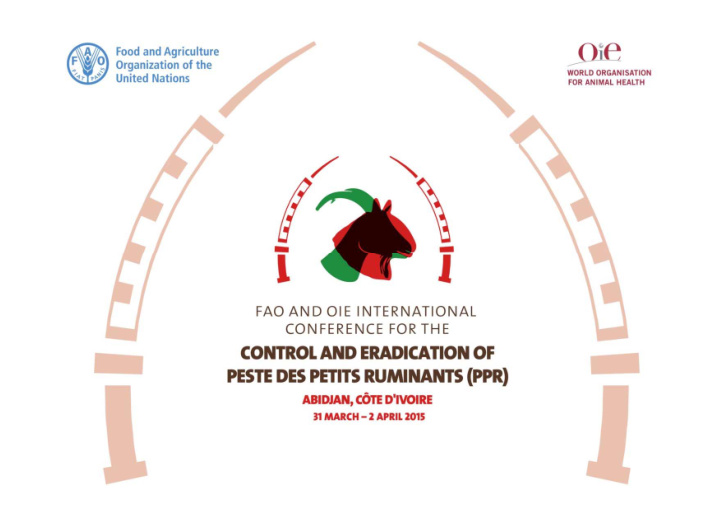



Ghazi Yehia Xavier Pacholek OIE Regional Representation for the Middle East PPR control and eradication challenges in the Middle East
Middle East characteristics Large small ruminants (SR) population 10% world sheep herd o 105 million heads o Iran: 4 th sheep herd worldwide 5% world goat herd
Middle East characteristics SR geographical distribution Near East Iran Syria Iran 11% 50% Iraq 20% 50% 4 th world 5% sheep herd Egypt KSA 6% 8% Arabian Peninsula 25% Yemen 12%
Middle East characteristics 28% small Syria 11% Iraq ruminants Iran 5% 50% population in countries Egypt with KSA 6% 8% severe political disturbances Yemen 12%
Middle East characteristics Crossroads of 3 continents Asia Europe Africa
Middle East characteristics Socio-economics aspects • Small holders mainly in traditional extensive production systems vulnerable human and animal populations +++ in countries with severe political disturbances • Impact of major SR diseases Livestock production Livelihood of populations Food security
Middle East characteristics Small ruminants’ regional trade 50 M SR slaughtered yearly for consumption 20-30% of total meat consumption No regional self-sufficiency Intense regional trade o 14 M heads imported yearly o Seasonal (religious feast) o 90% to the 6 GCC countries (KSA: 7.8 M) o from Eastern Africa (Ethiopia, Somalia, Sudan), Middle East (Iran, Syria, Turkey) and Australia o Risks linked to uncontrolled trade (traditional transboundary transhumance, smuggling, refugee populations…).
Middle East characteristics Livestock regional trade
PPR in Middle East Prevalence (OIE/WAHID) Not present Endemic Last Last Syria Syria occurrence occurrence Iraq Iraq Iran Iran Lebanon 1997 Jordan 2000 Egypt Egypt All UAE KSA KSA 2009 ME Bahrain at risk 2011 Syria Qatar Yemen Yemen
PPR in Middle East Vaccination Ring Mass vaccination vaccination Syria Syria Iran Iran Iraq Iraq Egypt Egypt KSA KSA No vaccination Yemen Yemen
PPR in Middle East PPRV lineage distribution
PPR in Middle East Vaccination Live attenuated PPRV vaccine (strain Nigeria 75/1) Imported Produced in Jordan, Egypt and KSA Estimation of 20-30 % vaccinated population at the regional level
Middle East challenges • Large animal population • Regional trade of livestock • Uncontrolled livestock movements (nat. and intern.) • Political disturbances • PPR endemic • Socio-economic impact • Uncoordinated national vaccination policies • Regional PPR vaccine production capacities
PPR in Middle East Regional FAO-OIE GF TADs workshop (Amman, Jordan, 2-4 March 2014) Supported a PPR regional strategy linked to the on coming Global strategy for PPR control & eradication Identified regional gaps o diagnostic & epidemiological capacities and networking o socioeconomic studies on the impact of PPR o control of SR movements o communication to raise political awareness & prioritize national PPR control programs
Thank you Ghazi Yehia Xavier Pacholek OIE Regional Representation for the Middle East g.yehia@oie.int x.pacholek@oie.int
Recommend
More recommend